In the world of saltwater fishing, nothing compares to reeling in a hefty snapper fish. These formidable creatures belong to the Lutjanidae family, showing off their distinctive features, such as their pointed teeth and unusual body shapes. Despite these traits, snapper fish species flourish in countless aquatic environments around the globe.
Types of Snapper Fish
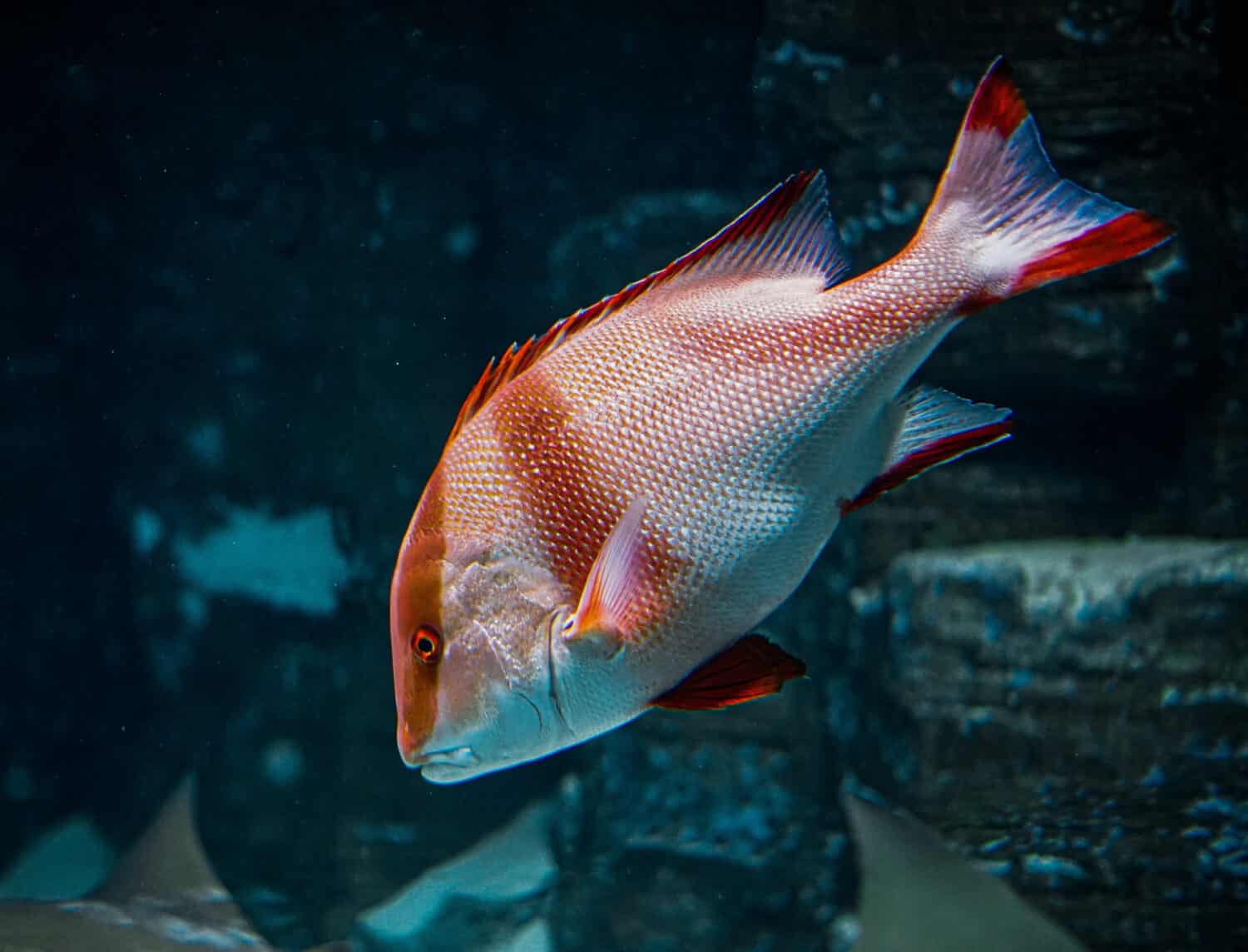
There are 113 types of snapper fish in the world.
©Oakland Images/Shutterstock.com
One of the most remarkable qualities of snapper fish is their ability to adapt to varying surroundings. For example, ranging from warm tropical oceans to freezing cold waters, these species can withstand an assortment of environments with impressive resilience. Snapper’s multipurpose survival skills explain why they have become such popular targets for anglers and beloved dishes on menus everywhere.
In this blog post, we’ll explore some interesting facts about these fish, such as where they live. You will also learn how you can distinguish types of snapper fish. Now, let’s rank these fish by size.

Yellowtail Snapper (Ocyurus chrysurus) 11-15 inches
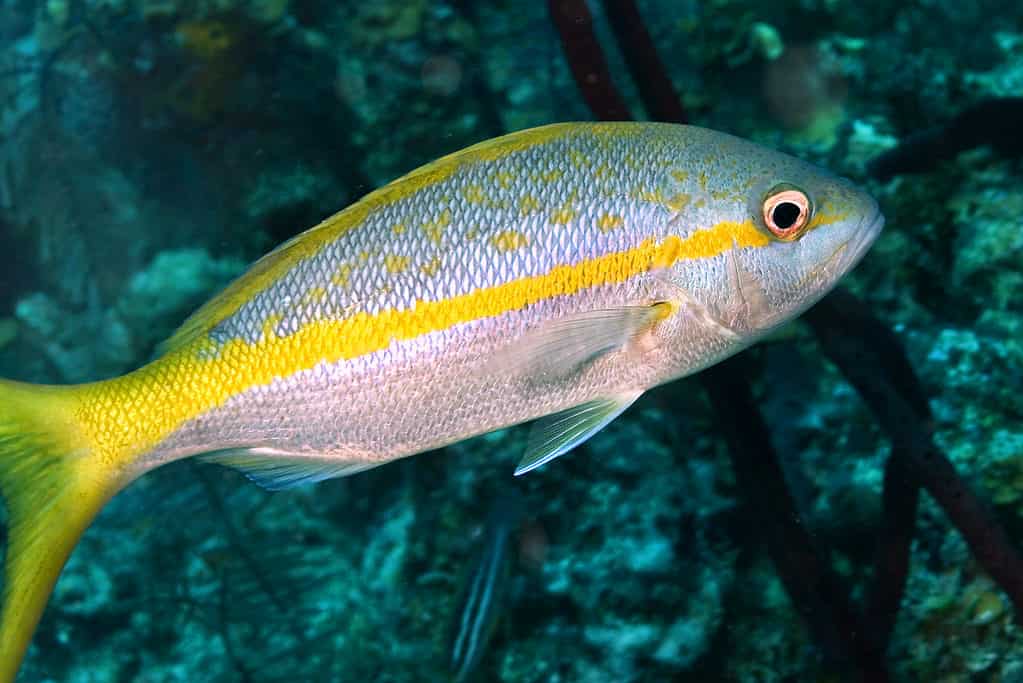
Yellowtail snapper is a popular type of snapper fish for commercial fishermen, thanks to its delicious taste.
©iStock.com/Alberto Carrera
Admired for its vibrant coloration, the yellowtail snapper holds a prominent position in the waters of the western Atlantic Ocean. Renowned for its delectable taste, yellowtail snappers are highly sought after by anglers who fish for leisure and commercial purposes. Unfortunately, overfishing and habitat destruction severely threaten the survival of yellowtail snappers.
The yellowtail snapper stands out from other fish with its vibrant yellow tail in contrast to its red upper body and silvery-white lower regions. Its slender form, complemented by large eyes, only adds to its distinctive appearance.
Schoolmaster Snapper (Lutjanus apodus) 12-22 inches
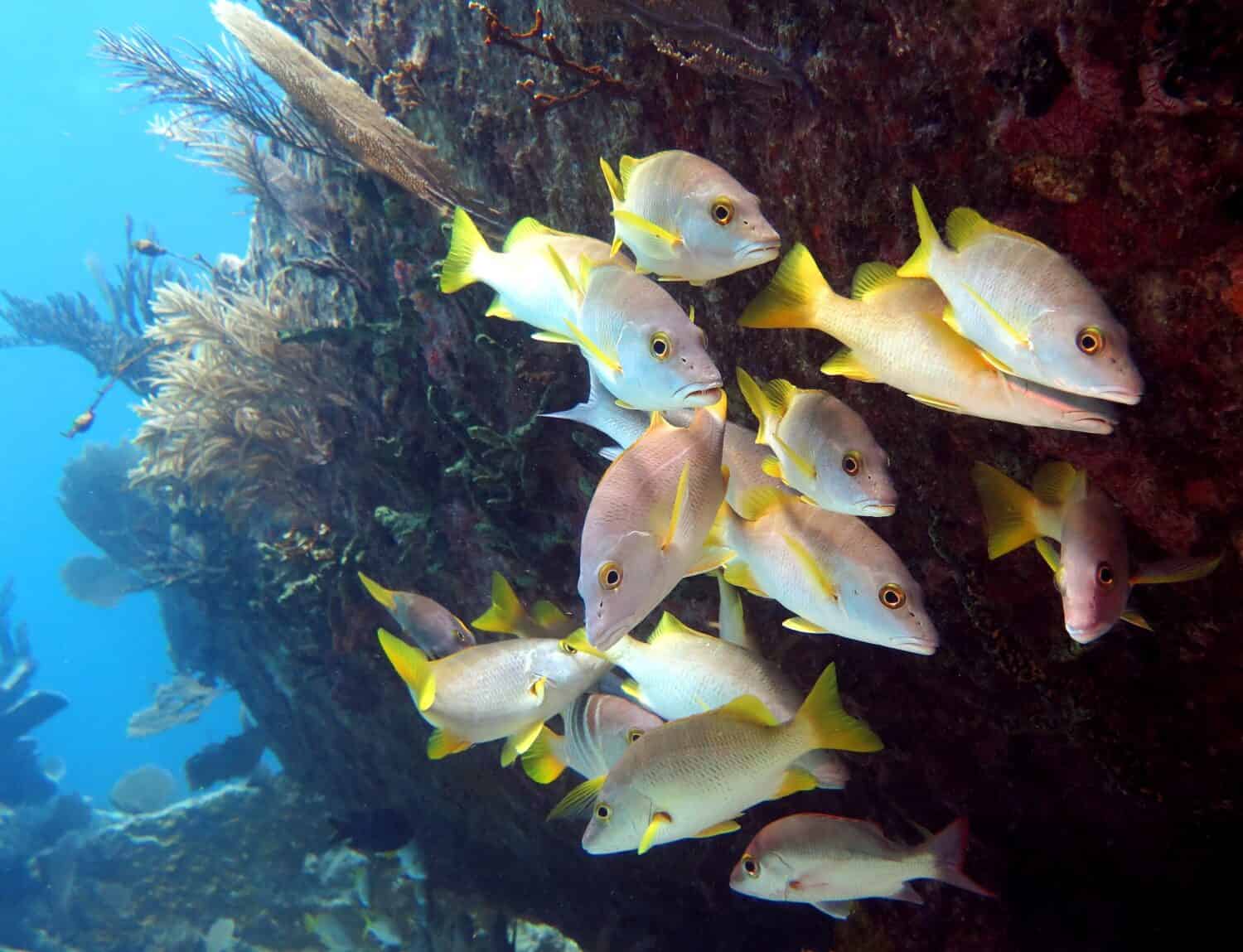
Schoolmaster snappers have an olive-gray body.
©Daryl Duda/Shutterstock.com
While exploring the coastal waters stretching from Florida to Brazil and the Caribbean, one may spot different species of schoolmaster fish. Schoolmaster snapper’s defining traits include a reddish-brown tint and yellowish stripes paired with a slightly sloped and broad forehead. Further, they boast delicate scales on their bodies, followed by a rounded tail shape.
Schoolmaster snappers are known for their unique social behavior, often seen in large schools of hundreds. In addition, the dominant male, who is usually the largest and most aggressive fish in the group, takes on a leadership role as he guides the others through their underwater lives.
Vermilion Snapper (Rhomboplites aurorubens) 14-24 inches

This fish shown is thought to be a vermillion snapper caught in North Carolina. They are known for dwelling deep within reefs and rocky bottoms.
©{JSR}, CC BY 2.0 – License
Found commonly in saltwater, the Vermilion Snapper is also referred to as the Beeliner or Night Snapper. These fish are known for dwelling deep within reefs and rocky bottoms at depths ranging between 100 to 400 feet. Spanning across a vast region of Caribbean and eastern shorelines, it can be observed from North Carolina to the Gulf waters.
Its pointed nose, forked tail, and wide mouth highlight its oblong body. It stands out with its small, smooth scales that are decorated with bright red to orange-red colors. One significant physical feature they own is the lateral line that runs from their gills to their tails.
Mangrove Snapper (Lutjanus griseus) 18-24 inches

You can identify these types of snappers by looking at their contrasting colors.
©John A. Anderson/Shutterstock.com
From Massachusetts to Brazil, the mangrove snapper fish swims its way into different coastal regions and estuaries with brackish water. Mangrove trees’ presence heavily influences the dwelling places of this fish species, as they commonly reside in them. They are also able to live among reefs and piers, including artificial structures like oil rigs.
One can easily identify these fish by their contrasting colors. They feature a dark upper body with shades of gray and brown, while the lower portion appears silver in color. They possess remarkable physical features like large and powerful teeth and a pointed skull which help them catch prey effortlessly.
Sailfin Snapper (Symphorichthys spilurus) 19-24 inches
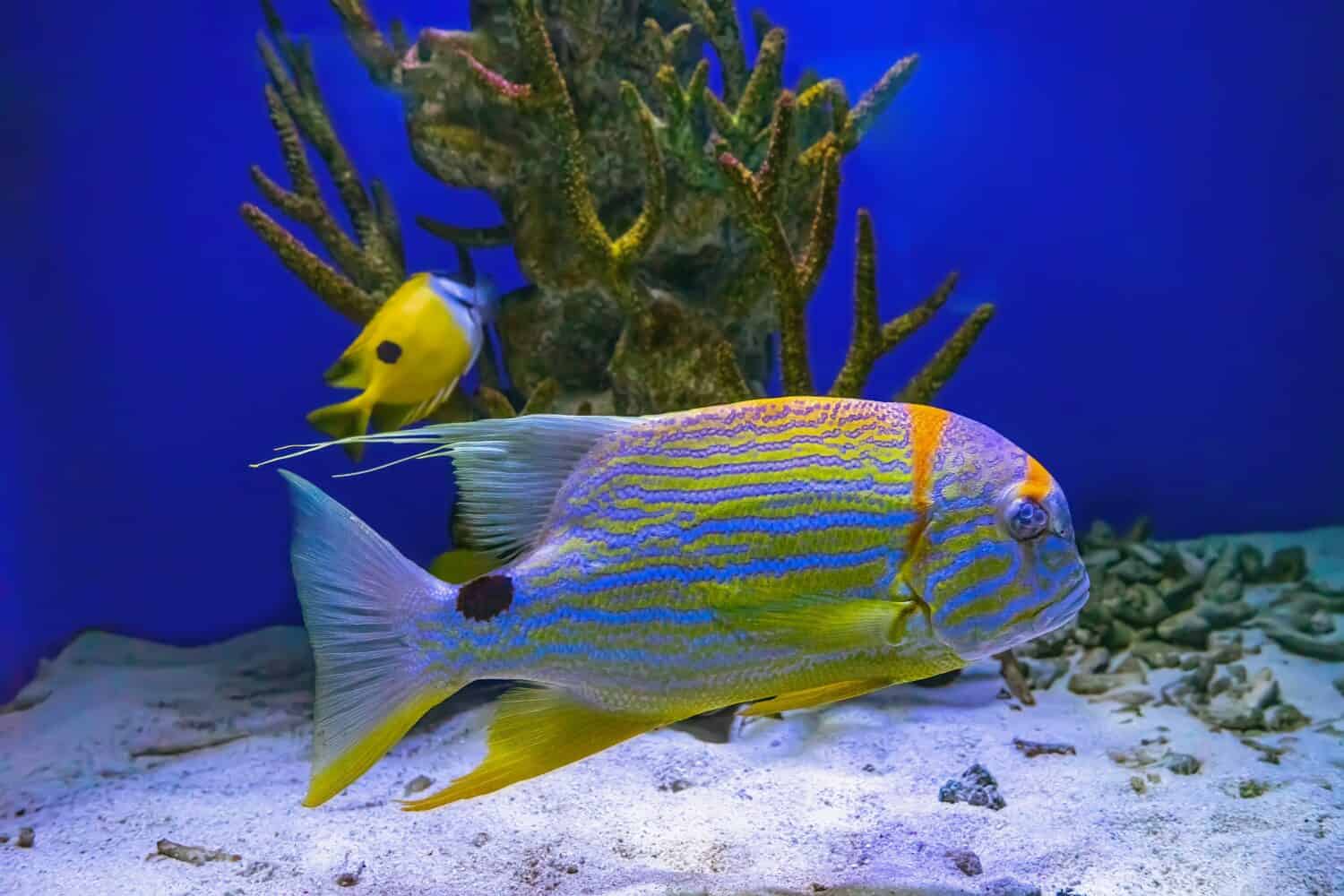
The Sailfin snapper gets its name from its fins.
©Katerina Maksymenko/Shutterstock.com
Sailfin snappers live in the seas off Southeast Asia, Australia, and the Indian Ocean islands, as they are indigenous to the western Pacific and Indian Ocean. Their traits include their striking red hue, long, sleek bodies, and tall dorsal fins resembling a sail. Additionally, they display broad, thick scales and a slightly concave head shape that sets them apart from other fish species.
This snapper fish species uses its dorsal fin in the breeding season for communication with fellow members of its kind and to entice potential mates.
Midnight Snapper (Lutjanus bengalensis) 21-24 inches

This snapper fish species has 10 spines on its dorsal fins.
©DJ Mattaar/Shutterstock.com
Midnight Snapper fish originate from the eastern coast of Africa but can now be found throughout much of the western and central Pacific Ocean. Their distinctive features include a short, compressed body with a wide mouth and a pointed snout. These fish have varying shades of red coloring ranging from pale pinkish-red to dark reddish-brown hues.
During their most active period, which happens to be nighttime, the midnight snapper exhibits nocturnal hunting behavior. The species is commonly known for lurking between the cracks and openings within coral reefs during daylight hours. Its feeding habit is notably aggressive as it securely captures its prey using its robust jaws.
Lane Snapper (Lutjanus synagris) 20-25 inches
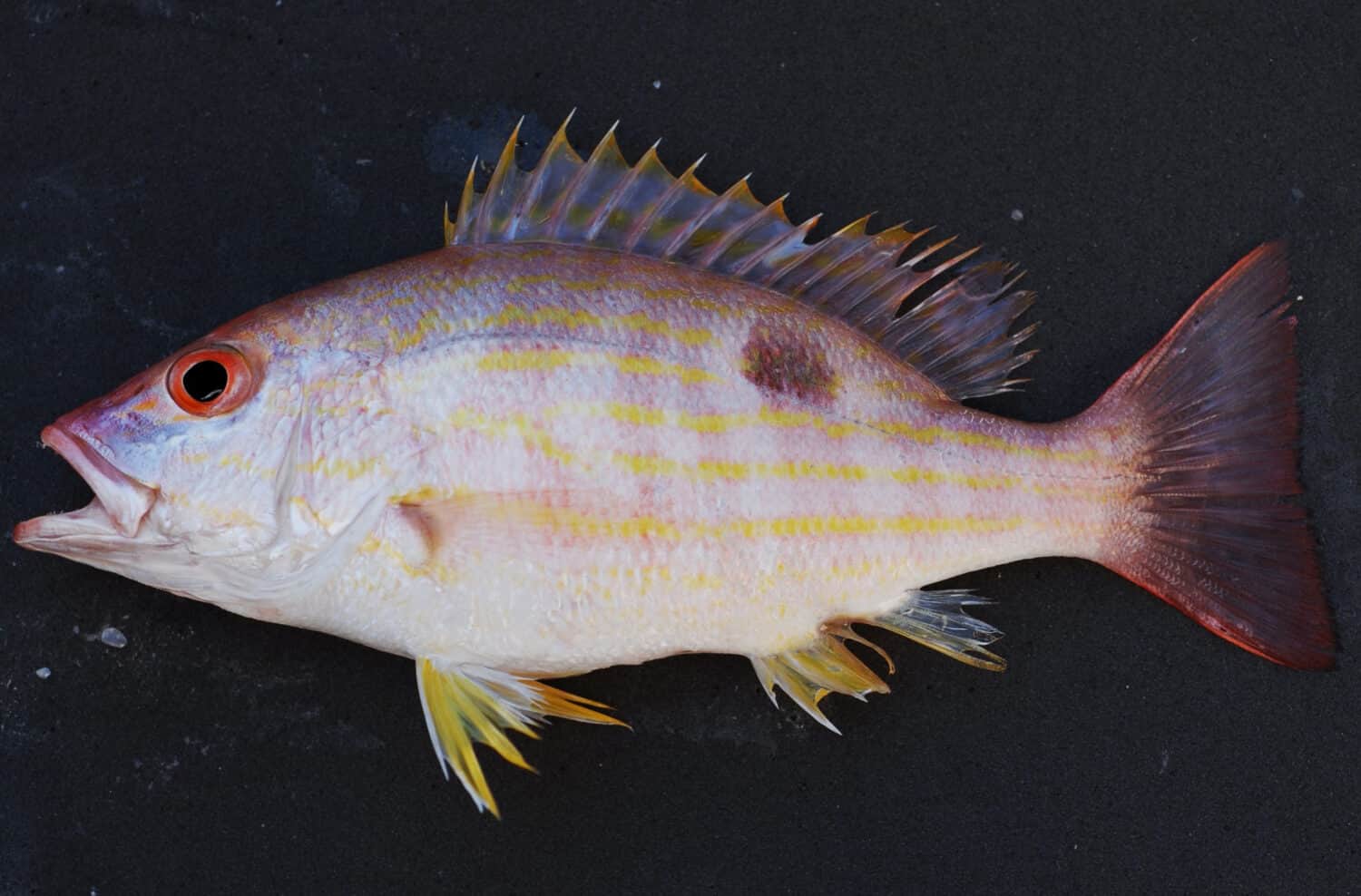
Lane snapper, or candy snapper, is a popular fish in the Gulf waters.
©lego 19861111/Shutterstock.com
This fish is native to the western Atlantic Ocean and the Caribbean Sea. It lives in shallow waters and makes its home in seagrass beds and coral reefs. Lane snapper fish are easily identifiable with vibrant colors and patterns. They boast a pointed head with a prominent jawline and reddish-pink fins. The distinctive shades of reds and pinks along their body are complemented by vertical yellow stripes running down either side.
The unique characteristic of the lane snapper fish is its ability to alter its color. This fish often displays a muted and dull color when in a dormant state. However, when experiencing stress or agitation, the snapper’s hue becomes more vivid and striking.
Blackfin Snapper (Lutjanus buccanella) 20-30 inches
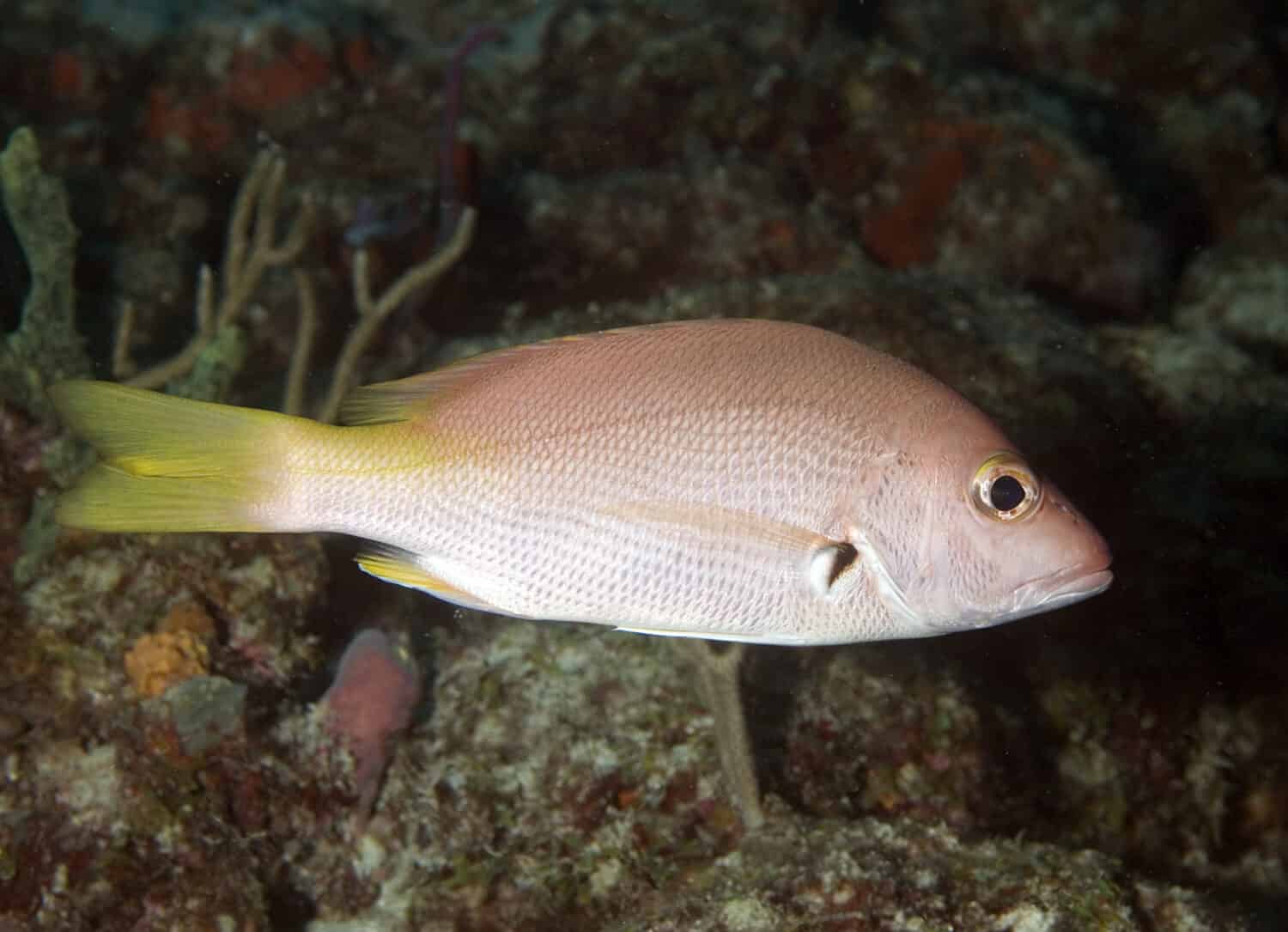
Blackfin snapper is a native fish species in the western Atlantic Ocean.
©Peter Leahy/Shutterstock.com
With its curved body, pointed snout, and big mouth filled with sharp teeth, the Blackfin snapper is perfectly adapted to the western Atlantic and Caribbean Sea’s warm waters. The fish’s sleek, elongated anatomy is characterized by a silvery-white underbelly that contrasts distinctly with its darker reddish-brown colored upper body.
Far from being drab, its scales feature striking black spots along the tips of its anal and pelvic fins. Thanks to an attention-grabbing black border, the dorsal fin stands out with even more of a dramatic flair.
Mutton Snapper (Lutjanus analis) 20-30 inches

Mutton snapper is listed as Near Threatened on the IUCN.
©John A. Anderson/Shutterstock.com
The Western Atlantic Ocean and the southern parts of Brazil have an abundance presence of mutton snapper fish. The mutton snapper has an elongated body shape, laterally compressed, and possesses a slightly rounded skull. Furthermore, the fish’s large mouth is characterized by a prominent lower jaw.
These snappers sport a horizontal black stripe running along their bodies from reddish-brown to grayish-brown in color. Additionally, mutton snapper fins often have distinctively reddish or yellowish hues. Apart from feeding on small fish and crabs, this species is unique because it has a great taste for squid.
Silk Snapper (Lutjanus vivanus) 17-32 inches

Typically occupying depths of 20 to 300 feet, these fish are common around reefs and rocky bottoms.
©Author Unknown/Public Domain – License
In the western Atlantic, silk snapper fish are abundant in the tropical seas. Typically occupying depths of 20 to 300 feet, these fish are common around reefs and rocky bottoms. The features of the silk snapper are easily recognized by their distinct physical traits. Their body shape is long and sleek, while a broad mouth extends to the rear of their eyes and is paired with a sharp, pointed nose.
The upper half of the fish displays a vivid rosy-pinkish red hue, while the lower part showcases a comparatively lighter pink color. The fins are exceptionally alluring, bearing shades of scarlet and pinkish-red that stand out remarkably. Additionally, one can notice their peculiar yellow eyes and the thin, silky scales covering their entire body.
Queen Snapper (Etelis oculatus) – 29-36 inches
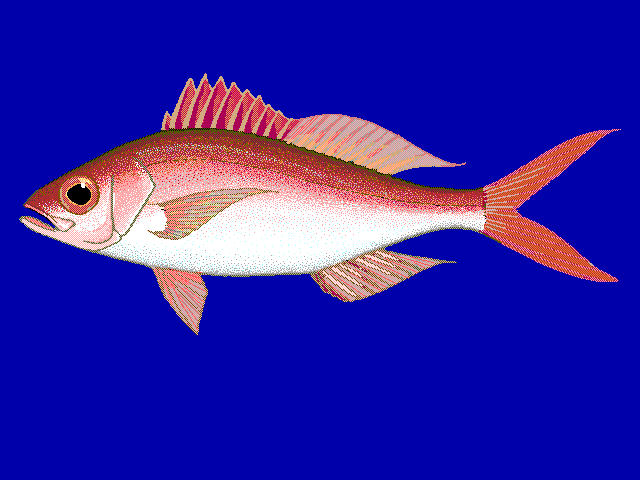
Queen snapper sport a reddish-pink upper body and a lighter golden-toned underbelly.
©Robbie Cada/Public domain – License
Ranging from depths of 100 to 900 feet, the Queen Snapper calls the Western Central Atlantic home. This fish species lives in various locations, including the Caribbean Sea, the Gulf of Mexico, and the southeastern coast of the United States. In addition, Its habitat preference includes proximity to rocky outcrops and coral reefs.
Sporting a reddish-pink upper body and a lighter golden-toned underbelly, this creature boasts impressive jaws packed with razor-sharp teeth. Its diet primarily consists of tiny fish and crustaceans, which it hunts down with keen eyesight. Being a hermaphrodite, the Queen Snapper is born as a female fish. However, it has an exceptional ability to change its sex whenever necessary.
Cubera Snapper (Lutjanus cyanopterus) – 36 inches
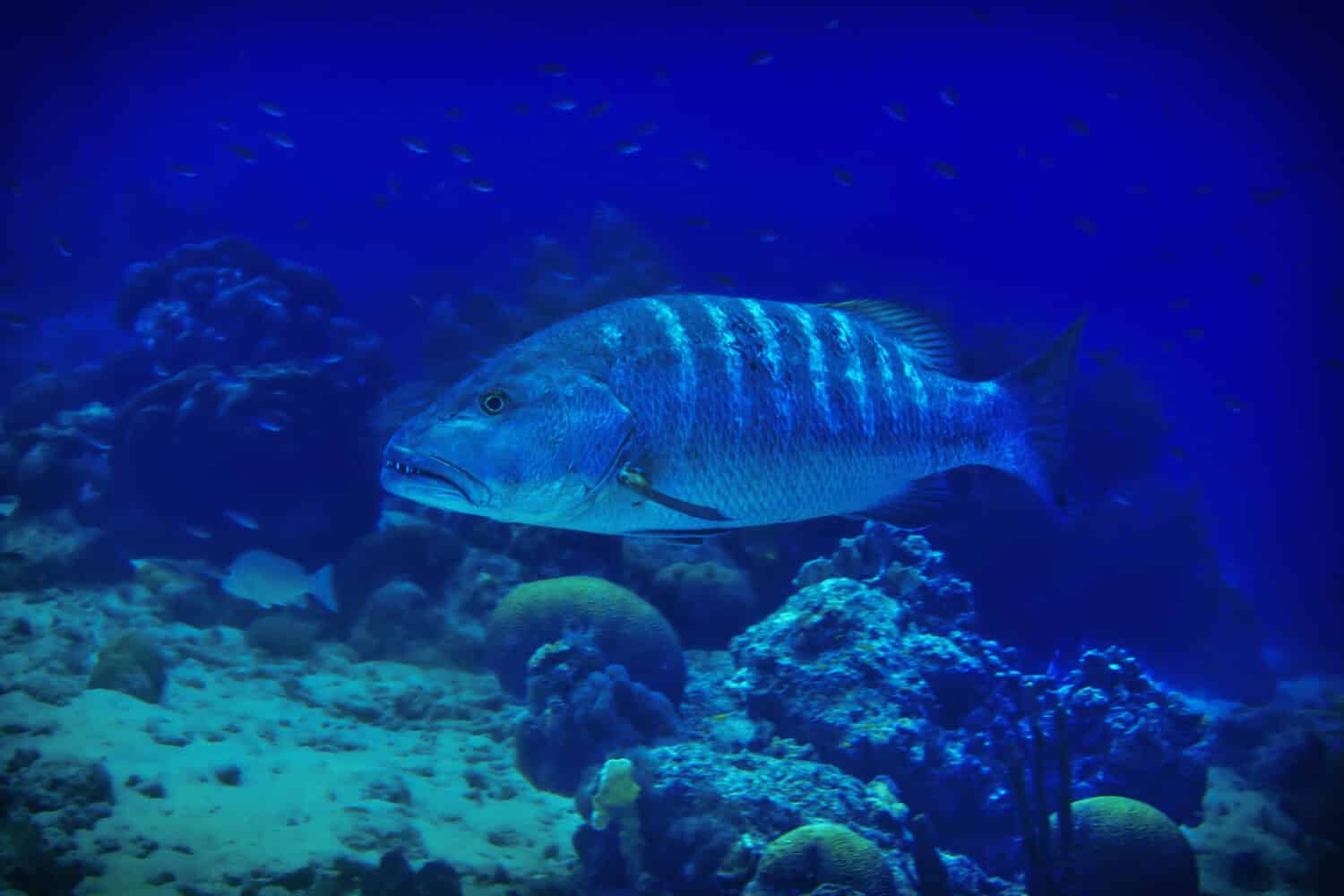
Cubera snappers are also known as the Cuban snapper.
©Lynn Archer/Shutterstock.com
Throughout South America’s coastline and the Caribbean Sea, one can expect to regularly witness the presence of the large and predatory cubera snapper. Cubera snappers exhibit a dark reddish-brown hue on their upper body and a silver-white shade on their belly. One distinctive feature of their appearance is the protruding lower jaw with intimidating sharp teeth. In addition, cubera snappers seek out an assortment of prey, including fish, crabs, and cephalopods. These predators can lurk in rocky regions or near reefs, where they skillfully capture their chosen meals.
Northern Red Snapper (Lutjanus campechanus) – 24-40 inches
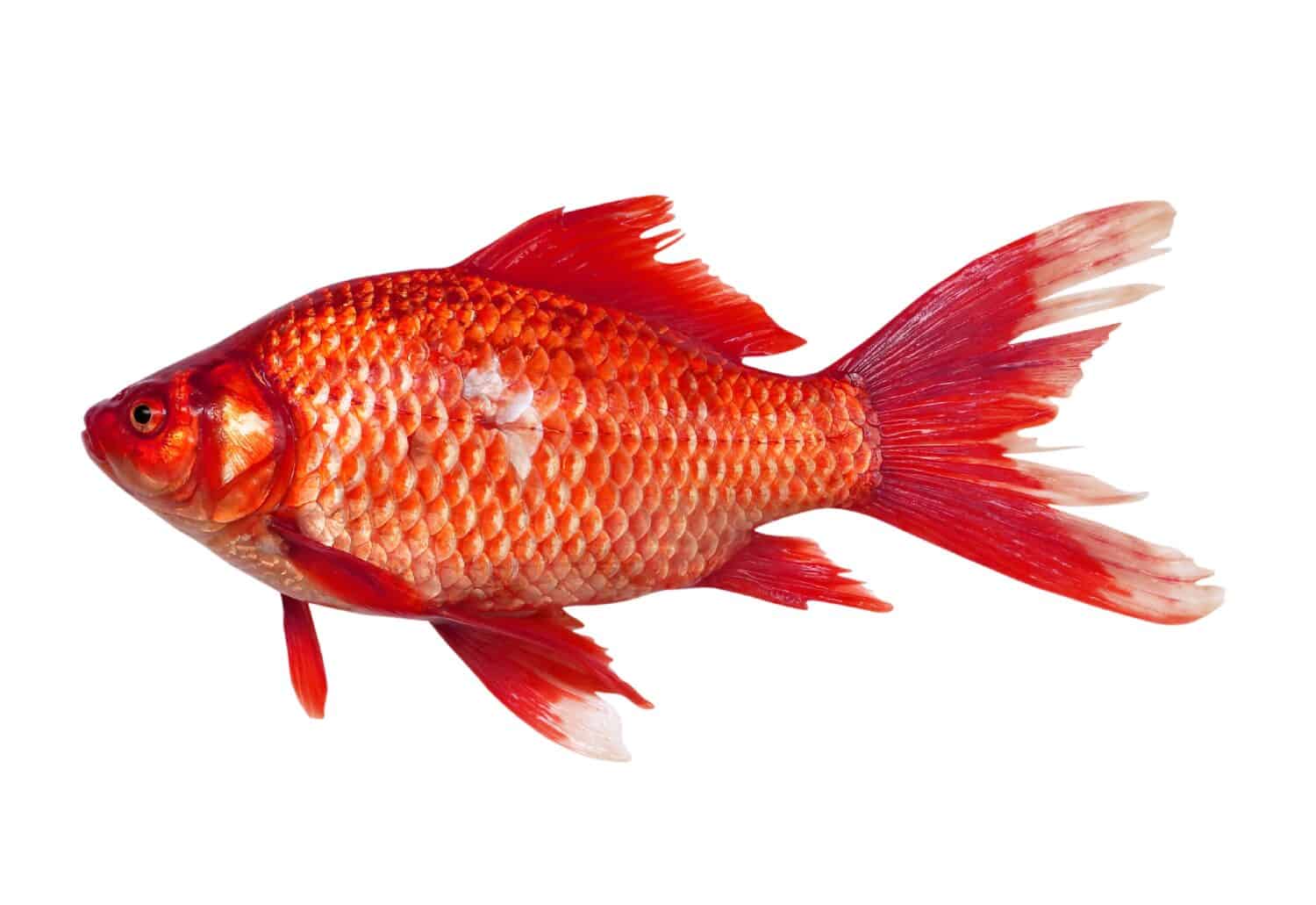
The Northern red snapper is easily distinguishable due to its body colors of reddish-pink and white.
©Abhishek Raviya/Shutterstock.com
Over time, the Northern red snapper adapted to life in unique environments like those in the Gulf of Mexico, North America, and Central America. Regarding fishing, these fish species have become popular amongst Americans.
The Northern red snapper is easily distinguishable due to its body colors of reddish-pink and white. As a result of their elongated physique, these fish have a pointed-shaped dorsal fin. Therefore, allowing them to glide through the water with ease, all thanks to their streamlined design.
Summary of the 13 Different Types of Snapper Fish Ranked By Size
Here are the 13 Different Types of Snapper Fish Ranked By Size:
| Rank | Species | Scientific Name | Size |
|---|---|---|---|
| 1 | Yellowtail Snapper | Ocyurus chrysurus | 11-15 inches |
| 2 | Schoolmaster Snapper | Lutjanus apodus | 12-22 inches |
| 3 | Vermilion Snapper | Rhomboplites aurorubens | 14-24 inches |
| 4 | Mangrove Snapper | Lutjanus griseus | 18-24 inches |
| 5 | Sailfin Snapper | Symphorichthys spilurus | 19-24 inches |
| 6 | Midnight Snapper | Lutjanus bengalensis | 21-24 inches |
| 7 | Lane Snapper | Lutjanus synagris | 20-25 inches |
| 8 | Blackfin snapper | Lutjanus buccanella | 20-30 inches |
| 9 | Mutton Snapper | Lutjanus analis | 20-30 inches |
| 10 | Silk Snapper | Lutjanus vivanus | 17-32 inches |
| 11 | Queen Snapper | Etelis oculatus | 29-36 inches |
| 12 | Cubera Snapper | Lutjanus cyanopterus | 36 inches |
| 13 | Northern Red Snapper | Lutjanus campechanus | 24-40 inches |
The photo featured at the top of this post is © Peter Leahy/Shutterstock.com
Thank you for reading! Have some feedback for us? Contact the AZ Animals editorial team.






